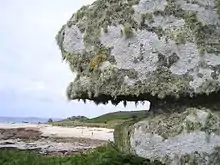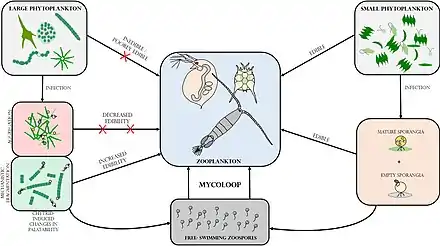Portal:Fungi
The Fungi Portal
_01.jpg.webp)
A fungus is any member of a large group of eukaryotic organisms that includes microorganisms such as yeasts and molds, as well as the more familiar mushrooms. The Fungi are classified as a kingdom that is separate from plants and animals. The discipline of biology devoted to the study of fungi is known as mycology or fungal biology, which is historically regarded as a branch of botany, even though genetic studies have shown that fungi are more closely related to animals than to plants. Fungi reproduce via spores and grow as hyphae, mycelia, and futher specialized structures. Fungal spores are often produced on specialized structures or in fruiting bodies, such as the head of a mushroom. Abundant worldwide, most fungi are mostly invisible to the naked eye because of the small size of their structures, and their cryptic lifestyles in soil, on dead matter, and as symbionts of plants, animals, or other fungi. Fungi perform an essential role in the decomposition of organic matter and have fundamental roles in nutrient cycling and exchange. They have long been used as a direct source of food, such as mushrooms and truffles, as a leavening agent for bread, and in fermentation of various food products, such as wine, beer, and soy sauce.
Since the 1940s, fungi have been used for the production of antibiotics, and, more recently, various enzymes produced by fungi are used industrially and in detergents. Fungi are also used as biological agents to control weeds and pests. Many species produce bioactive compounds called mycotoxins, such as alkaloids and polyketides, that are toxic to animals including humans. The fruiting structures of a few species are consumed recreationally or in traditional ceremonies as a source of psychotropic compounds. Fungi can break down manufactured materials and buildings, and become significant pathogens of humans and other animals. Losses of crops due to fungal diseases or food spoilage can have a large impact on human food supplies and local economies. Despite their importance on human affairs, little is known of the true biodiversity of Kingdom Fungi, which has been estimated at around 1.5 million species, with about 5% of these having been formally classified.
| More about fungi... |
Selected article

The fruit bodies of L. echinatum are 2–4 cm (0.8–1.6 in) wide by 2–3.5 cm (0.8–1.4 in) tall, supported by a small base, and densely covered with spines that are up to 0.6 cm (0.2 in) long. The spines can fall off in maturity, leaving a net-like pattern of scars on the underlying surface. Initially white in color, the puffballs turn a dark brown as they mature, at the same time changing from nearly round to somewhat flattened. Young specimens of L. echinatum resemble another edible spiny puffball, Lycoperdon pulcherrimum, but this latter species does not turn brown as it ages. The fruit bodies are edible when young, when the interior is white and firm and before it has turned into a powdery brown mass of spores. Laboratory tests have shown that extracts of the fruit bodies can inhibit the growth of several bacteria that are pathogenic to humans.
Selected species

While not widely consumed in the west, A. auricula-judae was used in folk medicine as recently as the 19th century, for complaints including sore throats, sore eyes and jaundice, and as an astringent. Today, the mushroom is still used for medicinal purposes in China, where soups featuring it are used as a remedy for colds; it is also used in Ghana, as a blood tonic. Modern research into possible medical applications have variously concluded that A. auricula-judae has antitumour, hypoglycemic, anticoagulant and cholesterol-lowering properties.
Things to do
If you want to help Wikipedia to improve its coverage of fungi, here are some things you can do...
- Assess some fungi articles.
- Join Wikipedia:WikiProject Fungi or ask on the talk page.
- Join the lichen task force.
- Review, improve, expand or clean some of the newly created fungi-related articles.
- Expand some high priority fungus stubs.
- Expand or sort other fungi-related stubs.
- Add images to articles in the list of unillustrated fungi articles, or add more articles to the list.
- Write fungi-related articles from scratch. For ideas of needed articles, see the redlinks on-
- Wikipedia:WikiProject Fungi/List of unwritten articles (high priority)
- Wikipedia:WikiProject Missing encyclopedic articles/Skysmith's list of missing articles/Biology/Fungi
- Members of Category:Lists of fungal species
- Review the fungi articles flagged as needing attention.
WikiProjects

WikiProjects related to fungi:
- WikiProject Science
- WikiProject Biology
- WikiProject Tree of Life
- WikiProject Fungi
- WikiProject Tree of Life
- WikiProject Biology
- WikiProject Medicine
- WikiProject Food
Selected picture

Did you know?
- ... that consumption of the psychoactive mushroom Psilocybe argentipes by mice who compulsively bury marbles significantly inhibits this behaviour?
- ... that the mushroom Entoloma austroprunicolor of Tasmania's wet forests changes from bluish-purple, to reddish purple, to purplish grey as it ages?
- ... that Disciotis venosa, Hygrophorus subalpinus, Mycena overholtsii, Plectania nannfeldtii, Ramaria botrytis, and Clitocybe glacialis are all mushrooms that grow in or near snowbanks?
- ... that the spiny puffball, an edible fungus, can inhibit the growth of several bacteria pathogenic to humans?
- ... that Cantharellus lateritius may typically be distinguished from other chanterelles by its smooth under surface?
General images -
Related portals
Topics
- Fungi: Bracket fungus, carnivorous fungus, coprophilous fungi, entomopathogenic fungus, evolution of fungi, lichen, mushroom, mycology (lichenology, mycotoxicology, paleomycology), mycorrhiza, pathogenic fungi, puffball, wood-decay fungus
- Fungal orders: Chytridiomycota, Blastocladiomycota, Neocallimastigomycota, Zygomycota, Glomeromycota. Dikarya: Ascomycota, Basidiomycota
- Fungi lists: Species: Agaricus species, Amanita species, Boletus species, Cortinarius species, Cyathus species, Hygrocybe species, Hygrophorus species, Inocybe species, Lactarius species, Mycosphaerella species, Panaeolus species, Psilocybe species, Russula species, Scleroderma species Other lists: Mycology journals, psilocybin mushrooms
- Uses: Edible mushroom, mushroom poisoning, psilocybin mushrooms, mushroom hunting, fungiculture, fermentation, baker's yeast, mycoremediation, lichenometry, mushroom dye
Categories
Wikimedia
Sources
-
 List of all portalsList of all portals
List of all portalsList of all portals -
 The arts portal
The arts portal -
 Biography portal
Biography portal -
 Current events portal
Current events portal -
 Geography portal
Geography portal -
 History portal
History portal -
 Mathematics portal
Mathematics portal -
 Science portal
Science portal -
 Society portal
Society portal -
 Technology portal
Technology portal -
 Random portalRandom portal
Random portalRandom portal -
 WikiProject PortalsWikiProject Portals
WikiProject PortalsWikiProject Portals





















.JPG.webp)













![Image 36Pennate diatom from an Arctic meltpond, infected with two chytrid-like [zoo-]sporangium fungal pathogens (in false-colour red). Scale bar = 10 µm. (from Marine fungi)](../I/Pennate_diatom_infected_with_two_chytrid-like_fungal_pathogens.png.webp)





